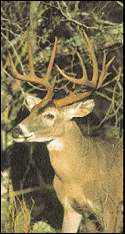|
Whitetail Wrap-up
 By Russell Tinsley By Russell Tinsley
Page 2
TPWD biologists say a drought is a short-term affair, that observations are based on historical trends and records from past deer seasons. And Young points out that most hunters will see little difference from previous seasons, this especially being true in the Edwards Plateau region, where almost half the state's whitetails are found. Only in recent years have we seen a trend toward management of the deer herd in the Hill Country, and the results are proving beneficial.
Young explains: "During the drought of '96 many landowners lowered deer and exotic numbers and sold livestock to take some pressure off the range. The rains from then to the early part of this year produced good acorn crops and abundant weedy plants, which are favorite deer foods. Thus, places where this occurred were in better shape for the drought this year."
But he adds that this isn't the case on ranches where prolonged overgrazing by deer, livestock and exotics has damaged the range. In these circumstances the effects of the dry conditions will be evident. "On ranches where deer numbers were kept at the proper level, the prospects are fair with average antler development-much better, though, than on ranches where deer numbers are not controlled," Young says. "We can't do much with a drought once it takes hold, but we can be prepared to lessen the impact. This season is a good time to work on those overpopulations. Get rid of a bunch of does and spike bucks. Don't let the talk of a big die-off influence your decision. As we noticed after the '96 drought, recovery was rapid."
While the Edwards Plateau has always been known for deer numbers, the South Texas Brush Country has traditionally produced more record-book bucks than any other region. If any trophy bucks are forthcoming this season in the state, they likely will be from the Brush Country, despite a parched range that stifled antler and body growth in the spring and throughout much of the summer.
In fact, Young's colleague Jerry Cooke, director for TPWD' s big game wildlife and upland ecology program, says that because white-tailed bucks entered the spring in good condition, some land managers might not see a noticeable decline in antler quality this year. But at the same time, they might not see as many deer, either.
"The first physical sign of drought on deer is a change in an individual animal' s behavior," Cook says further. "Deer disperse in search of food and water. If it stays dry and we get poor acorn production, bait probably will work well."
The brutal heat wave of summer, when the thermometer got stuck above 100 degrees, took no prisoners. However, we have gone through droughts before and the deer have survived-make that flourished-once weather patterns returned to normal. Expect much the same this hunting season if the drought breaks. A soaking rain like Charley brought to town can make folks forget those budget-wrecking summertime utility bills, money that could be better spent on deer hunting. And if you are going to be successful this season, dig a little deeper in the pocketbook to keep the feeders filled. That's a key to success in any part of the state. The drought of '98 spared no one.
Deep into the summer, however, the TPWD hadn't heard of any significant die-off of deer, and in most places the deer were in remarkably good condition, everything considered. The whitetail is a wonderfully adaptable animal. It learns to eat what becomes available, such as mesquite beans which are readily available in the Edwards Plateau and South Texas-especially during dry conditions.
If rainfall is above average, however, production of mesquite beans and desert-like plants are down while the acorn crop is up. This year the acorn crop is slim and spotty at best. Once the acorns are gone, deer will have to find something else in the Edwards Plateau and other parts of the state where oaks are dominant, such as the Oak Prairie ecological region. Young says the acorn crop is a major factor in deer survival and reproduction in the Oak Prairie and affects hunter success as well. With a sub-par acorn crop, hunting will be adversely affected. Give the Oak Prairie a grade of below average.
Fact is, that is a good appraisal statewide, but it could be upgraded to average or even better if sustained rains finally come between now and the season
opener. It appears, though, that among hunters, the season will probably be one of mixed emotions, no matter where they hunt. Even if the season is not up to expectations, most hunters won' t see that much of a difference between this season and the last one. But those who seek the trophy bucks can' t expect such a bonanza two years in a row, even under the best of conditions.
Bryan Richards, program leader for the Texas Big Game Awards Program, described last season as "The year it rained antlers." This year, through the dry summer months anyway, might best be remembered as the year when it rained almost nothing-little moisture and few if any outstanding trophy deer.
It looks like that kind of year.
# # # #
page 1 / page 2
| 
